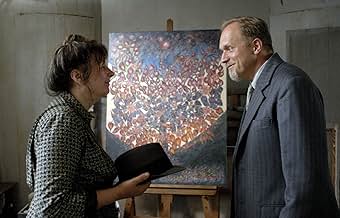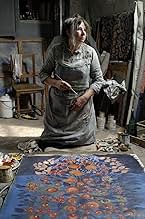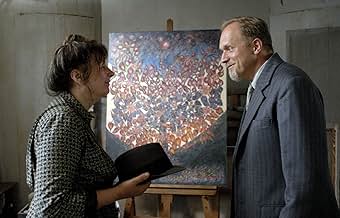VALUTAZIONE IMDb
7,4/10
6613
LA TUA VALUTAZIONE
Basato sulla vita della pittrice francese Séraphine de Senlis.Basato sulla vita della pittrice francese Séraphine de Senlis.Basato sulla vita della pittrice francese Séraphine de Senlis.
- Premi
- 20 vittorie e 7 candidature totali
Léna Breban
- Soeur Marguerite
- (as Léna Bréban)
Sandrine Bodenes
- Marie-Louise
- (as Sandrine Bodènés)
Anne Benoît
- Madame Delonge
- (as Anne Benoit)
Trama
Lo sapevi?
- QuizSince the film's release, the number of visitors at the museum of Senlis exhibiting Séraphine's works has quadrupled (August 2009).
- BlooperWilhelm Uhde is portrayed as having a goatee beard throughout the course of the film. Portraits of him show generally a clean-shaven man or one with the small moustache.
- Curiosità sui creditiThe credits list the names of the paintings which are seen in the film - 10 paintings by Séraphine and the artworks owned by Uhde and Kolle.
- Colonne sonoreConsonent laudes!
Written by Louis Rousseau
Performed by Yolande Moreau, Françoise Lebrun and Léna Breban
Recensione in evidenza
Veteran actress Yolande Moreau gives a dedicated performance in this biopic about the neo-primitive, or "naive," or "outsider" flower painter Séraphine Louis (1864-1948), now called Séraphine de Senlis, from the town where she worked. An orphan looked down on by all, she survived barely by doing cleaning and laundry paid by the job, but in her little room in town at night by candlelight made strange, visionary paintings of flowers in large clusters, looking like diamonds or insects. Raised and cared for in early life by nuns, she sang to the Virgin when she finished a painting. Beautifully photographed, meditative, with a strong sense of the quietude of rural France in the teens and twenties, this picture doesn't provide deep insight into either Séraphine or the German art collector who discovered and supported her, Wilhelm Uhde (Ulrich Tukur, another veteran; he has one of the secondary leads in The Lives of Others). Uhde deserves his own biopic. He was the first to purchase the works of Picasso and discovered the great modern primitive Henri "Le Douanier" Rousseau.
Slowly, methodically, the film shows how Uhde finds out by chance that the haggard looking middle aged woman cleaning up in the big rented house he's living in in Senlis with his sister is doing unique paintings on wood. Nobody else around appreciates them or, in fact, understands modern art. He buys all her work from Séraphine and urges her to concentrate on her art. But WWI comes, and as a German he is forced to leave precipitously, leaving behind his little notebook and most of the art he's collected in France.
Uhde returns years later with his sister and also a male lover, Helmut Kolle (Nico Rogner), a talented young German expressionist painter dying of TB, and rents another house in the area. He comes across Séraphine's work and finds it more ambitious and much more brilliant. He puts her on a generous monthly stipend. She shows signs of mania, and her disappointment when she finds the Paris exhibition must be put off due to the worldwide financial crisis leads her into insanity. The trajectory is ever downward, though the final scenes suggest that her last years in a sanatorium may have been spend it serenity, close to the nature she loved.
This film is thorough and handsomely made, but a little too much on the dutiful and academic side. It has parallels as a story with Bruno Nuytten's 1988 Camille Claudel, but it has neither the level of drama nor the presence of Gérard Depardieu and Isabelle Adjani (as Rodin and Claudel) to give it energy. As director Provost has said, Uhde had a "dark side": his willingness to virtually abandon Séraphine when things got rough for her, and not to bother looking for her when he first returns to France after the War. Provost leaves this mysterious, which is just historically, but unsatisfying cinematically. But Provost did apparently help organize the recent Musée Maillol exhibition of Séraphine's work. And this film is a thought-provoking addition to the on-screen literature of outsider or visionary art.
The film opened in theaters in Paris on October 1, 2008 to respectful if not overly enthusiastic reviews. It has been bought by Music Box in the US, but no release has been announced. Shown as part of the Rendez-Vous with French Cinema at Lincoln Center, NYC, in March 2009.
Slowly, methodically, the film shows how Uhde finds out by chance that the haggard looking middle aged woman cleaning up in the big rented house he's living in in Senlis with his sister is doing unique paintings on wood. Nobody else around appreciates them or, in fact, understands modern art. He buys all her work from Séraphine and urges her to concentrate on her art. But WWI comes, and as a German he is forced to leave precipitously, leaving behind his little notebook and most of the art he's collected in France.
Uhde returns years later with his sister and also a male lover, Helmut Kolle (Nico Rogner), a talented young German expressionist painter dying of TB, and rents another house in the area. He comes across Séraphine's work and finds it more ambitious and much more brilliant. He puts her on a generous monthly stipend. She shows signs of mania, and her disappointment when she finds the Paris exhibition must be put off due to the worldwide financial crisis leads her into insanity. The trajectory is ever downward, though the final scenes suggest that her last years in a sanatorium may have been spend it serenity, close to the nature she loved.
This film is thorough and handsomely made, but a little too much on the dutiful and academic side. It has parallels as a story with Bruno Nuytten's 1988 Camille Claudel, but it has neither the level of drama nor the presence of Gérard Depardieu and Isabelle Adjani (as Rodin and Claudel) to give it energy. As director Provost has said, Uhde had a "dark side": his willingness to virtually abandon Séraphine when things got rough for her, and not to bother looking for her when he first returns to France after the War. Provost leaves this mysterious, which is just historically, but unsatisfying cinematically. But Provost did apparently help organize the recent Musée Maillol exhibition of Séraphine's work. And this film is a thought-provoking addition to the on-screen literature of outsider or visionary art.
The film opened in theaters in Paris on October 1, 2008 to respectful if not overly enthusiastic reviews. It has been bought by Music Box in the US, but no release has been announced. Shown as part of the Rendez-Vous with French Cinema at Lincoln Center, NYC, in March 2009.
- Chris Knipp
- 22 feb 2009
- Permalink
I più visti
Accedi per valutare e creare un elenco di titoli salvati per ottenere consigli personalizzati
- How long is Seraphine?Powered by Alexa
Dettagli
Botteghino
- Budget
- 3.674.000 € (previsto)
- Lordo Stati Uniti e Canada
- 884.613 USD
- Fine settimana di apertura Stati Uniti e Canada
- 38.637 USD
- 7 giu 2009
- Lordo in tutto il mondo
- 9.402.702 USD
- Tempo di esecuzione2 ore 5 minuti
- Colore
- Mix di suoni
- Proporzioni
- 1.85 : 1
Contribuisci a questa pagina
Suggerisci una modifica o aggiungi i contenuti mancanti



































